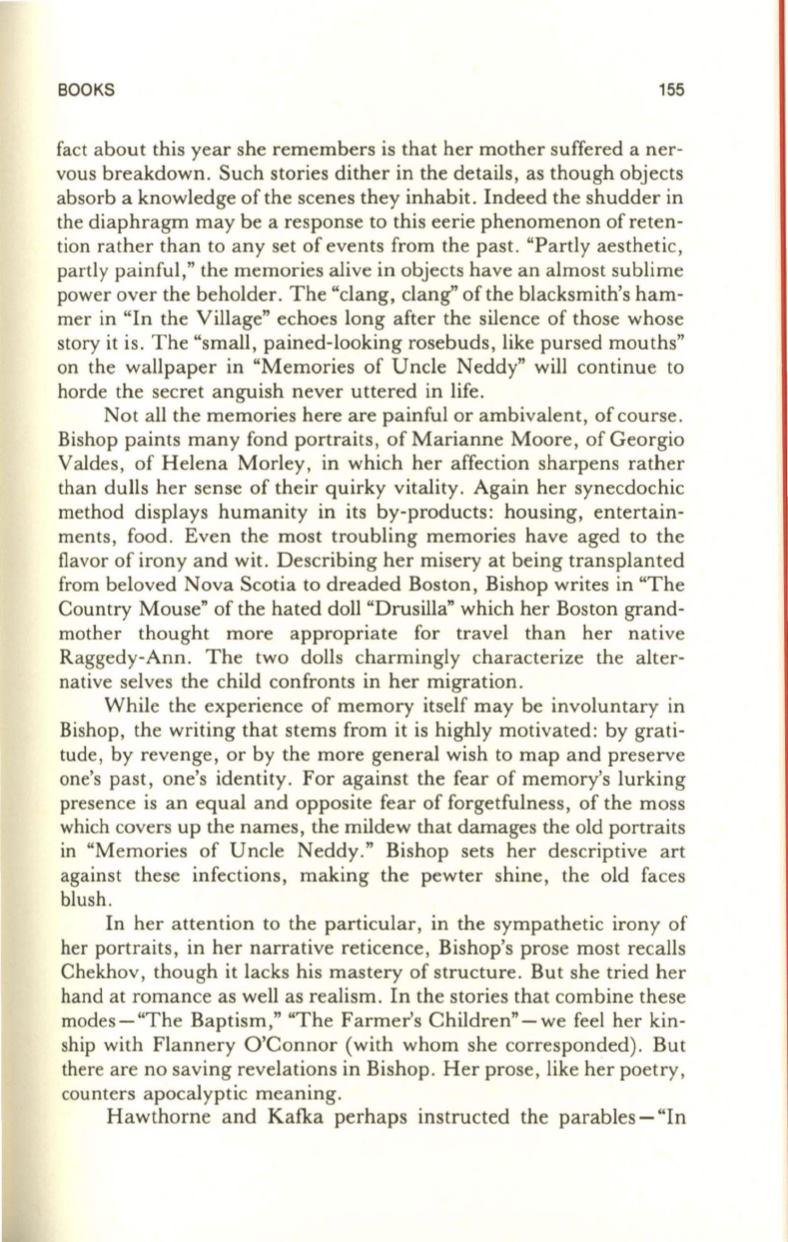
BOOKS
155
fact about this year she remembers is that her mother suffered a ner–
vous breakdown. Such stories dither in the details, as though objects
absorb a knowledge of the scenes they inhabit. Indeed the shudder in
the diaphragm may be a response to this eerie phenomenon of reten–
tion rather than to any set of events from the past. "Partly aesthetic,
partly painful," the memories alive in objects have an almost sublime
power over the beholder. The "clang, clang" of the blacksmith's ham–
mer in "In the Village" echoes long after the silence of those whose
story it is. The "small, pained-looking rosebuds, like pursed mouths"
on the wallpaper in "Memories of Uncle Neddy" will continue to
horde the secret anguish never uttered in life.
Not all the memories here are painful or ambivalent, of course.
Bishop paints many fond portraits, of Marianne Moore, of Georgio
Valdes, of Helena Morley, in which her affection sharpens rather
than dulls her sense of their quirky vitality. Again her synecdochic
method displays humanity in its by-products: housing, entertain–
ments, food. Even the most troubling memories have aged to the
flavor of irony and wit. Describing her misery at being transplanted
from beloved Nova Scotia to dreaded Boston, Bishop writes in "The
Country Mouse" of the hated doll "Drusilla" which her Boston grand–
mother thought more appropriate for travel than her native
Raggedy-Ann. The two dolls charmingly characterize the alter–
native selves the child confronts in her migration.
While the experience of memory itself may be involuntary in
Bishop, the writing that stems from it is highly motivated: by grati–
tude, by revenge, or by the more general wish to map and preserve
one's past, one's identity. For against the fear of memory's lurking
presence is an equal and opposite fear of forgetfulness, of the moss
which covers up the names, the mildew that damages the old portraits
in "Memories of Uncle Neddy." Bishop sets her descriptive art
against these infections, making the pewter shine, the old faces
blush .
In her attention to the particular, in the sympathetic irony of
her portraits, in her narrative reticence, Bishop's prose most recalls
Chekhov, though it lacks his mastery of structure. But she tried her
hand at romance as well as realism. In the stories that combine these
modes - "The Baptism," "The Farmer's Children" - we feel her kin–
ship with Flannery O'Connor (with whom she corresponded). But
there are no saving revelations in Bishop. Her prose, like her poetry,
counters apocalyptic meaning.
Hawthorne and Kafka perhaps instructed the parables - "In


